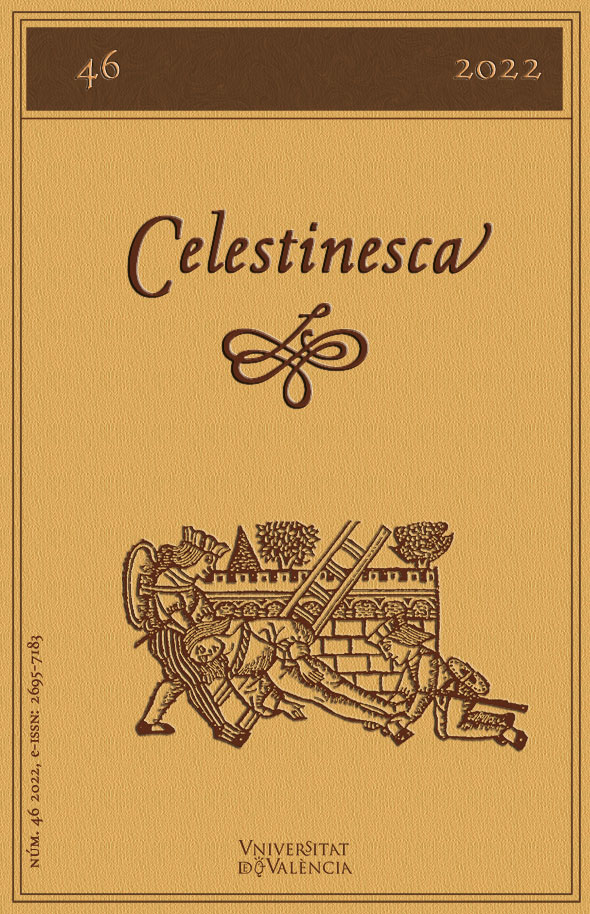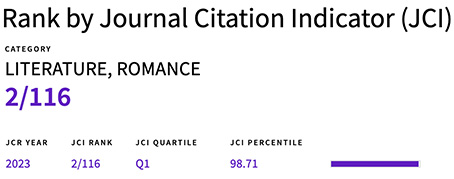Apetito «contra natura»: Celestina and her same-sex desires
DOI:
https://doi.org/10.7203/Celestinesca.46.21582Keywords:
Homoeroticism, Bisexual, Sexuality, Same-sex desire, Double-entendre Abstract
Abstract
Fernando de Rojas’ La Celestina drips with sexuality as represented by prostitution, double entendre, and hypersexuality but some scholars have balked at the opportunity to investigate the significance of Celestina’s same-sex desires that permeate through the pages in her interactions. This essay delves into a queer reading of Dorothy Severin’s edition of La Celestina using widely accepted heteronormative scholarship but applied to the female relationships that occur within. Areúsa’s mal de madre, Calisto’s dolor de muelas, and Elicia’s mysterious dolor all benefit from Celestina’s cures and satisfy Celestina’s sexual appetite for same-sex desires. I also suggest that Celestina’s relationship with Claudina is more than a close sisterhood and parallels that of the reverence Calisto holds for Melibea. Finally, I contemplate Pármeno’s societal representation of repulsion toward “the Other.” I argue that Celestina’s passionate past with his mother motivates his murderous intention toward Celestina.
 Downloads
Downloads
 References
References
Balderston, Daniel, and José Maristany (2005). «The Lesbian and Gay Novel in Latin America», in The Cambridge Companion to the Latin American Novel, edited by Efrain Kristal, Cambridge University Press, pp. 200–16.
Bidwell-Steiner, Marlen (2015). «Sex Acts in La Celestina: An Ars Combinatoria of Desire». Renaissance & Reformation/Renaissance et Reforme, vol. 38, no. 4, Iter, Inc., Fall, pp. 121–43. https://doi.org/10.33137/rr.v38i4.26376
Boswell, John (1980). Christianity, Social Tolerance, and Homosexuality: Gay people in Western Europe from the Beginning of the Christian Era to the Fourteenth Century. The University of Chicago Press.
Burshatin, Israel (1999). «Written on the Body: Slave or Hermaphrodite in Sixteenth-Century Spain», in Queer Iberia: Sexualities, Cultures, and Crossings from the Middle Ages to the Renaissance, edited by Josiah Blackmore et al., Duke University Press, pp. 420–56.
Canet, José (2018). «De nuevo sobre la autoría de La Celestina». Letras [Online], 1.77 (2018): 35–68. https://erevistas.uca.edu.ar/index.php/LET/article/view/1710 (fecha último acceso: 01/12/2022)
Cantalapiedra Erostarbe, Fernando (1986). Lectura semiótico formal de «La Celestina». Edition Reichenberger.
Cantizano Pérez, Félix (2010). «De las ninfas del Olimpo a las ninfas de las tasqueras: una visión de la prostitución en la España del Siglo de Oro», eHumanista, vol. 15, pp. 154–75.
Costa Fontes, Manuel da (2004). «Celestina as an Antithesis of the Blessed Mother», in Art of Subversion in Inquisitorial Spain: Rojas and Delicado, Purdue University Press, pp. 101–41.
— (1984). »Celestina’s "Hilado" and Related Symbols», Celestinesca, vol. 8, no. 1, pp. 3–13. https://doi.org/10.7203/Celestinesca.9.19605
Dangler, Jean (2001). «Transgendered Sex and Healing in Celestina». Celestinesca, vol. 25, no. 1–2, p. 69–82. https://doi.org/10.7203/Celestinesca.25.19973
Eesley, Anne (1987). «Implications of Celestina’s "La Claudina"». Romance Notes, vol. 28, no. 2, Winter, pp. 137–41.
Garci-Gómez, Miguel (1981). «"Huevos Asados": Afrodisíacos para el marido de Celestina», Celestinesca, vol. 5, no. 1, pp. 13–22. https://doi.org/10.7203/Celestinesca.5.19528
Gerli, E. Michael (2011). «Celestina, Mistress of Desire», in Celestina and the Ends of Desire, University of Toronto Press, pp. 37–63.
— (2009). «El placer de la mirada: Voyeurismo, fetichismo y la movilizacion del deseo en Celestina», in El mundo social y cultural de «La Celestina», edited by Ignacio Arellano and Jesús M. Usunáriz, Iberoamericana – Vervuert, pp. 191–210. https://doi.org/10.31819/9783964566102-011
— (1999). «Dismembering the Body Politic: Vile Bodies and Sexual Underworlds in Celestina», in Queer Iberia: Sexualities, Cultures, and Crossings from the Middle Ages to the Renaissance, edited by Josiah Blackmore et al., Duke University Press, pp. 369–93. https://doi.org/10.1215/9780822382171
Gossy, Mary S (1989). The Untold Story: Women and Theory in Golden Age Texts. The University of Michigan Press.
Haro Cortés, Marta (1993). «Erotismo y arte amatoria en el discurso médico de la Historia de la donzella Teodor». Revista de Literature Medieval, vol. 5, pp. 113–26. http://hdl.handle.net/10017/5206 (fecha último acceso: 01/12/2022)
Hutcheson, Gregory S (2001). «Leonor López de Córdoba and the Configuration of Female-Female Desire», in Same Sex Love and Desire Among Women in the Middle Ages, edited by Francesca Canadé and Pamela Sheingorn, Palgrave, pp. 251–75.
Illades Aguiar, Gustavo (2017). «The Poetics of Voice, the Performance, and the Meaning of Celestina», in A Companion to «Celestina», Brill, pp. 41–57. https://doi.org/10.1163/9789004349322_004
Lacarra, María Eugenia (1993). «La Evolución de La Prostitución En La Castilla Del Siglo XV y La Mancebía de Salamanca En Tiempos de Fernando de Rojas», in Fernando de Rojas and «Celestina»: Approaching the Fifth Centenary, Hispanic Seminary of Medieval Studies, pp. 33–78.
Lacarra Lanz, Eukene (2009). «Homoerotismo femenino en los discursos normativos medievales», Siempre soy quien ser solía: estudios de literatura española medieval en homenaje a Carmen Parrilla, Universidade da Coruña, pp. 205–28.
— (2010). «Representaciones de Homoerotismo Femenino En Algunos Textos Literarios Medievales». Estudios Humanísticos. Filología, no. 32, pp. 81–103. https://doi.org/10.18002/ehf.v0i32.2873
Lawrance, Jeremy N. H. (1993). «The Tragicomedia De Calisto y Melibea and Its "Moralitie"». Celestinesca, vol. 17, no. 2, pp. 85–110. https://doi.org/10.7203/Celestinesca.17.19835
Moore, Stephen D.; Kent L. Brintnall, and Joseph A. Marchal (2018). «Introduction. Queer Disorientations: Four Turns and a Twist», in Sexual Disorientations: Queer Temporalities, Affects, Theologies, edited by Kent L. Brintnall, Joseph A. Marchal, and Stephen D. Moore. Fordham University Press, pp. 1–44.
Palafox, Eloísa (2007). «Celestina y Su Retórica de Seducción: Comida, Vino y Amor En El Texto de La Tragicomedia». Revista Canadiense de Estudios Hispánicos, vol. 32, no. 1, pp. 71–88.
Richardson, Alan (2002). «Apostrophe in Life and in Romantic Art: Everyday Discourse, Overhearing, and Poetic Address». Style, vol. 36, no. 3, pp. 363–385.
Rank, Jerry R. (1980). «The Uses of "Dios" and the Concept of God in La Celestina». Revista Canadiense de Estudios Hispánicos, vol. 5, no. 1, pp. 75–91.
Reay, Barry, and Kim M. Phillips (2011). Sex Before Sexuality: A Premodern History, Polity.
Rojas, Fernando de (2000). La Celestina. Edited by Dorothy Sherman Severin and Maite Cabello, 12th ed., Cátedra.
Saguar García, Amaranta (2012). «Influencia de la hipérbole sacroprofana bíblica sobre la interpretación y la estructura de Celestina», in La tinta en la clepsidra. Fuentes, historia y tradición en la literatura hispánica, PPU, pp. 15–24.
Severin, Dorothy Sherman (1979). «Humour in La Celestina». Romance Philology, vol. 32, no. 3, pp. 274–291.
— (1995). «Witchcraft in Celestina». Papers of the Medieval Hispanic Research Seminar, pp. 7–55.
Shipley, George A (1975). «Concerting through Conceit: Unconventional Uses of Conventional Sickness Images in La Celestina». The Modern Language Review, vol. 70, no. 2, pp. 324–32.
Snow, Joseph T (2000). «The Sexual Landscape of Celestina: Some Observations». Calíope, vol. 6, no. 1/2, pp. 149–166. https://muse.jhu.edu/article/672369 (fecha último acceso: 01/12/2022)
— (1986). «Celestina’s Claudina», in Hispanic Studies in Honor of Alan D. Deyermond: A North American Tribute, edited by John S. Mieltich, Hispanic Seminary of Medieval Studies, pp. 257–77.
Torquemada, María Jesús (2014). «Homosexualidad femenina y masculina en relación con el delito de sortilegios». eHumanista: Journal of Iberian Studies, no. 26, Department of Spanish & Portuguese, pp. 87–116.
West, Geoffrey (1979). «The Unseemliness of Calisto’s Toothache». Celestinesca, vol. 3, no. 1, pp. 3–10. https://doi.org/10.7203/Celestinesca.3.19482
Velasco, Sherry (2022). «Listening to Lesbians in Early Modern Spain», in The Routledge Hispanic Studies Companion to Early Modern Spanish Literature and Culture, edited by Rodrigo Cacho Casal and Caroline Egan, Routledge, pp. 584–600. https://doi.org/10.4324/9781351108713-43
Downloads
Published
How to Cite
-
Abstract2019
-
PDF641
Issue
Section
License
![]() Celestinesca is committed to the dissemination of knowledge, that is why access to its contents is free and is ruled by a Creative Commons Attribution-NonCommercial-NoDerivatives 4.0 license.
Celestinesca is committed to the dissemination of knowledge, that is why access to its contents is free and is ruled by a Creative Commons Attribution-NonCommercial-NoDerivatives 4.0 license.
Authors retain the rights to their works. Therefore, they can disseminate them and deposit them in the repository, institutional or not, that they wish. However, they are kindly requested to do so by providing the full bibliographic reference and the corresponding DOI.
Celestinesca does not charge authors for submitting, processing, reviewing or publishing their articles.





